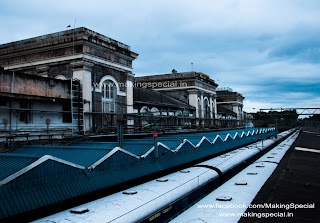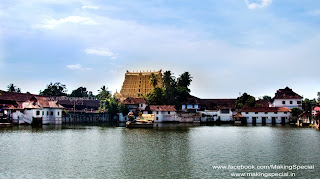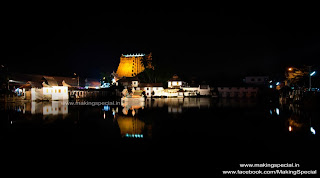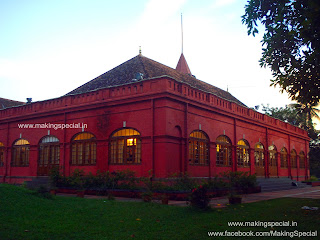THIRUVANANTHAPURAM PHOTOS
Photo taken by : Tito Kochuveettil
Thiruvananthapuram also known as Trivandrum,
is the capital of the Indian state of Kerala and the
headquarters of the Thiruvananthapuram District. It is
located on the west coast of India near the extreme south of the mainland.
Referred to by Mahatma Gandhi as "Evergreen city of India", the city is characterized by
its undulating terrain of low coastal hills and busy commercial alleys. The
city has a population of 752,490 inhabitants and a population of around 1.68
million in the urban agglomeration and is the
most populous city corporation and the fifth largest urban agglomeration in
Kerala. Thiruvananthapuram contributes 80% of the state's software exports and
is the major IT hub of the state.
The city is home to central and state government offices and
organizations. Apart from being the political nerve centre of Kerala
The city gets its name from the Malayalam
word thiru-anantha-puram meaning the "City of Lord Ananta". The name
derives from the deity
of the Sri Padmanabhaswamy temple at the centre
of the city. Anantha is the serpent Shesha on whom
Padmanabha or Vishnu
reclines. This temple of Vishnu reclining on Anantha remains the
iconic landmark of the city.
It is also considered as one of the 10
greenest cities in India. Thiruvananthapuram was ranked as the best city in
Kerala to live in by a recent Times
of India survey. The city is also ranked as the best city in India for
Housing and Transport by a survey conducted by India Today.
The
city was officially referred to as Trivandrum until 1991, when the government
decided to reinstate the city's original name Thiruvananthapuram
 |
| Thiruvananthapuram Railway station |
| Kottakkakam - Thiruvananthapuram |
Sree Padmanabhaswamy Temple
Sree Padmanabhaswamy temple is a Vedic temple dedicated to Lord Vishnu located in Thiruvananthapuram, India, in the state of Kerala. The shrine is run by a trust headed by the royal family of Travancore. The temple is one of 108 Divya Desams (Holy Abodes of Vishnu) – principal centres of worship of the deity in Vaishnavism. Lord Balarama,
according to Srimad Bhagavatam (10.79.18), visited Phalgunam (now known
as Thiruvananthapuram) as part of his teerthyatra, took bath in
Panchapsaras (Padmatirtham) and made a gift of ten thousand cows to holy
men. The temple is glorified in the Divya Prabandha, the early medieval Tamil literature canon of the Tamil Alvar saints (6th–9th centuries AD), with structural additions made to it throughout the 16th century, when its ornate Gopuram was constructed. The Temple is a replica of the famous Sri Adikesavaperumal Temple at Thiruvattar. Sri Padmanabhaswamy Temple gave its name to Kerala’s state capital Ananda refers to Sree Padmanabha Himself.
Hindu scriptures refer to the Supreme Being as 'Sachidananda' (Absolute
Truth, Absolute Consciousness and Absolute Bliss).
The Principal Deity, Padmanabhaswamy, is enshrined in the "Anantha-sayanam" posture (in the eternal sleep of Yoga-nidra on the serpent Anantha). The Maharajah of Travancore bears the title, "Sree Padmanabhadasa’ (Servant of Lord Padmanabha).
Sri Padmanabhaswamy Temple Gopuram the foundation of the present gopuram was laid in 1566. The temple has a 100-foot, seven-tier gopuram made in the Pandyan style. The temple stands by the side of a tank, named Padma Theertham (meaning the lotus spring). The temple has a corridor with 365 and one-quarter sculptured granite-stone pillars with elaborate carvings which stands out to be an ultimate testimonial for the Vishwakarma sthapathis in sculpting this architectural masterpiece. This corridor extends from the eastern side into the sanctum sanctorum. An eighty-foot flag-staff stands in front of the main entry from the prakaram(closed precincts of a temple). The ground floor under the gopuram (main entrance in the eastern side) is known as the 'Nataka Sala' where the famous temple art Kathakali was staged in the night during the ten-day uthsavam (festival) conducted twice a year, during the Malayalam months of Meenam and Thulam.
 |
| Padmanabhaswamy temple |
 |
| Padmanabhaswamy temple and the Temple Pond @ Evening |
 |
| Padmanabhaswamy temple and the Temple Pond @ Night |
| Big Idol of Pandavas displayed during Panguni festival |
Napier Museum
The Napier Museum is an art and natural history museum situated in Thiruvananthapuram
The
museum was established in 1855. In 1874, the old Museum Building was demolished
and foundation for the new building was laid. The new building was named after Lord Napier, the Governor of Madras from 1866-1872. The
architectural masterpiece was designed by Robert Chisholm, the consulting Architect
of the Madras Government and the construction was
completed in 1880. Napier Museum is a landmark in the city with its unique
ornamentation and architectural style with gothic roof and minarets.
The Indo-Saracenic
structure also boasts a natural air conditioning system.
The
museum houses a rare collection of archaeological and historic artifacts,
bronze idols, ancient ornaments, a temple
chariot and ivory carvings. It also contains the Sri Chitra Art
Gallery, which contains works from Raja Ravi
Varma and Nicholas Roerich, as well as examples of Mughal
and Tanjore art.
The Museum grounds
also hold a Zoological garden, which is one of the oldest
in India.
| Napier Museum |
| Window @ Napier Museum |
| Napier Museum @ Night |
| view @ Napier Museum |
| Night view @ Napier museum |
| Tree @ Napier museum |
| Italian marble Lion statue @ Napier museum |
Kuthira Malika
Puthen Malika Palace most popularly known as Kuthira Malika (Mansion of Horses), is a palace built by Swathi Thirunal Rama Varma, on the south-eastern side of Padmanabhaswamy temple in Thiruvananthapuram.The palace gets its name from the 122 horses that are carved into the wooden wall brackets that support the southern roof. The official name of the palace is Puthen Malika (New Mansion). The palace forms part of a vast complex of royal buildings in the vicinity of Padmanabhaswamy Temple. The building was left unoccupied for more than a century, following the demise of Swathi Thirunal in 1846.
Built in the 1840s, Kuthira Malika is a fine example of traditional Kerala architecture, with its typical sloping roofs, overhanging eaves, pillared verandahs and enclosed courtyards. Intricate carvings adorn the wooden ceilings with each room having a distinctive pattern. The construction of the palace was completed by 5000 workers in four years. The palace is made from teakwood, rosewood, marble, and granite. The roof of the palace is made of wood and 42 beams support the carved patterns. The roof is supported by granite pillars. Floral motifs dot the ceiling of the verandah. The main 16 rooms of the palace are constructed in 16 different patterns. In all, the palace contains 80 rooms of which 20 were opened for visitors in 1995. The floor inside the palace is made of egg whites, charcoal, and limestone which make it cold and smooth even in hot weather conditions. The concert venue built in the palace premises uses traditional sound reflectors comprising of 50 clay pots hung upside down from the ceiling.
A portion of Kuthira Malika has been converted to a Palace Museum that houses some of the assets owned by the Travancore Royal Family. Although 80 rooms are there in the palace, only 20 is open for visitors. Guided tour is available inside the palace. The palace collections include 14 life-size Kathakali mannequins, Belgian and Italian mirrors, crystal chandeliers, paintings, a giant Belgian harpoon,armaments, musical instruments, traditional furniture, a musical tree which produces 8 sounds on tapping, and other artifacts. On the right side of the mannequins are the ivory cradles of various sizes. The palace has on display two royal thrones, one made from 24 elephant tusks (Dantasimhasana) and the other of Bohemian crystal with the Tranvancore emblem 'conch' adorning the top of the backrest. The palace has a large collection of idols and sculptures made from white marble.
On the first floor are rooms that once served as the audience chamber, the library and an alcove that Swathi Thirunal used for meditating and for conceiving many of his famous musical compositions. This place offers a direct view of the Padmanabhaswamy temple gopuram. The small wooden stair at this place contains carvings of peacock, elephant, and dragon. Ceiling of the rooms contain paintings of parrot, peacock, and elephant. One of the rooms displays an illusion portraint of Sree Chithira Thirunal Balarama Varma, painted by Svetoslav Roerich. The face and the shoes of the king appear facing the onlooker from every corner of the room.
Built in the 1840s, Kuthira Malika is a fine example of traditional Kerala architecture, with its typical sloping roofs, overhanging eaves, pillared verandahs and enclosed courtyards. Intricate carvings adorn the wooden ceilings with each room having a distinctive pattern. The construction of the palace was completed by 5000 workers in four years. The palace is made from teakwood, rosewood, marble, and granite. The roof of the palace is made of wood and 42 beams support the carved patterns. The roof is supported by granite pillars. Floral motifs dot the ceiling of the verandah. The main 16 rooms of the palace are constructed in 16 different patterns. In all, the palace contains 80 rooms of which 20 were opened for visitors in 1995. The floor inside the palace is made of egg whites, charcoal, and limestone which make it cold and smooth even in hot weather conditions. The concert venue built in the palace premises uses traditional sound reflectors comprising of 50 clay pots hung upside down from the ceiling.
A portion of Kuthira Malika has been converted to a Palace Museum that houses some of the assets owned by the Travancore Royal Family. Although 80 rooms are there in the palace, only 20 is open for visitors. Guided tour is available inside the palace. The palace collections include 14 life-size Kathakali mannequins, Belgian and Italian mirrors, crystal chandeliers, paintings, a giant Belgian harpoon,armaments, musical instruments, traditional furniture, a musical tree which produces 8 sounds on tapping, and other artifacts. On the right side of the mannequins are the ivory cradles of various sizes. The palace has on display two royal thrones, one made from 24 elephant tusks (Dantasimhasana) and the other of Bohemian crystal with the Tranvancore emblem 'conch' adorning the top of the backrest. The palace has a large collection of idols and sculptures made from white marble.
On the first floor are rooms that once served as the audience chamber, the library and an alcove that Swathi Thirunal used for meditating and for conceiving many of his famous musical compositions. This place offers a direct view of the Padmanabhaswamy temple gopuram. The small wooden stair at this place contains carvings of peacock, elephant, and dragon. Ceiling of the rooms contain paintings of parrot, peacock, and elephant. One of the rooms displays an illusion portraint of Sree Chithira Thirunal Balarama Varma, painted by Svetoslav Roerich. The face and the shoes of the king appear facing the onlooker from every corner of the room.
Swathi Sangeethotsavam
The courtyard of Kuthira Malika is the venue for Swathi Sangeethotsavam (also known as Kuthira Malika Festival), a yearly music festival commemorating the legacy of Swathi Thirunal. This music festival is conducted from 6 to 12 January every year. It attracts many of the leading stalwarts of Carnatic and Hindustani classical music.
Kanakakkunnu Palace
Kanakakkunnu Palace near the Napier museum.Today the palace and its sprawling grounds are the venue for many cultural meets and programmes. An all India Dance Festival (October to March) is organised by the Department of Tourism every year. During this period the classical Indian Dance performances are conducted every day. There are several tourists streaming from many foreign countries every year.
It is said to be built by Sree Moolam Thirunal.It has been later used by the travancore royal family to entertain its guests and serve non vegetarian food as the royal family was vegetarian. It is now protected by the tourism department the palace plays host to a lot of cultural meets and programs. The Indian National Trust for Art and Cultural Heritage (INTACH) has listed this place as a heritage monument.
Located about 800 meters north east of the Napier Museum in the heart of Trivandrum city, Kanakakunnu Palace is one of the last architectural vestiges of the colonial era. Built during the reign of Travancore king Sree Moolam Thirunal (1885−1924), the palace served as the main venue for royal banquets. Later Swathi Thirunal, one of Travancore’s popular rulers, refurbished the palace and constructed tennis courts in the premises. He also did use it for a few years as a summer retreat. Boasting a Kerala style facade, the Travancore royal family used the house to entertain guests. Inside you will see massive crystal chandeliers and an array of exquisite pieces of royal furniture – a testimony to the lavish lifestyle of the Thirunal kings who had a penchant for music and art. Add to it a picturesque setting on the crest of a small hill lush with meadows, grooves and flowering shrubs.
Now under the Kerala government’s wing, the palace complex walls-in the Nishagandhi open-air auditorium and Sooryakanthi auditorium. A popular haunt of culture vultures in the city, the auditoriums are the venues for various cultural meets and programs. The prestigious All India Dance Festival aka Nishagandhi festival is hosted annually by the Department of Tourism at the Nishagandhi open-air auditorium. Indian classical dance exponents from across the country come down to participate in the festival.
It is said to be built by Sree Moolam Thirunal.It has been later used by the travancore royal family to entertain its guests and serve non vegetarian food as the royal family was vegetarian. It is now protected by the tourism department the palace plays host to a lot of cultural meets and programs. The Indian National Trust for Art and Cultural Heritage (INTACH) has listed this place as a heritage monument.
Located about 800 meters north east of the Napier Museum in the heart of Trivandrum city, Kanakakunnu Palace is one of the last architectural vestiges of the colonial era. Built during the reign of Travancore king Sree Moolam Thirunal (1885−1924), the palace served as the main venue for royal banquets. Later Swathi Thirunal, one of Travancore’s popular rulers, refurbished the palace and constructed tennis courts in the premises. He also did use it for a few years as a summer retreat. Boasting a Kerala style facade, the Travancore royal family used the house to entertain guests. Inside you will see massive crystal chandeliers and an array of exquisite pieces of royal furniture – a testimony to the lavish lifestyle of the Thirunal kings who had a penchant for music and art. Add to it a picturesque setting on the crest of a small hill lush with meadows, grooves and flowering shrubs.
Now under the Kerala government’s wing, the palace complex walls-in the Nishagandhi open-air auditorium and Sooryakanthi auditorium. A popular haunt of culture vultures in the city, the auditoriums are the venues for various cultural meets and programs. The prestigious All India Dance Festival aka Nishagandhi festival is hosted annually by the Department of Tourism at the Nishagandhi open-air auditorium. Indian classical dance exponents from across the country come down to participate in the festival.
 |
| Kanakakkunnu Palace @ Evening |
 |
| Kanakakkunnu Palace @ Evening |
 |
| National flag @ kanakakunnu palace |
Kovalam
Kovalam is a beach town by the Arabian Sea in Thiruvananthapuram city, Kerala, India, located around 16 km from the city center.Kovalam means a grove of coconut trees and true to its name the village
offers an endless sight of coconut trees. It is also known as the
paradise of the south.Kovalam first received attention when the Regent Maharani Sethu Lakshmi Bayi of Travancore constructed her beach resort, Halcyon Castle, here towards the end of the 1920s. Thereafter the place was brought to the public eye by her nephew the Maharaja of Travancore.
The European guests of the then Travancore kingdom discovered the
potentiality of Kovalam beach as a tourist destination in the 1930s.
However, Kovalam shot into limelight in the early seventies with
arrivals of the masses of hippies on their way to Ceylon in the Hippie Trail.
This exodus started the transformation of a casual fishing village of
Kerala into one of the most important tourist destinations in all India.
| Kovalam Light House |
Valiyathura sea bridge
Valiathura is a suburb of Thiruvananthapuram, the capital of Kerala, India. This was once the only port along the South Kerala coast. When Kochi
became the prominent port in Kerala, Valiyathura lost its significance
as a major port. Now Valiathura is considered as a fishing port.
Valiathura is famous for its pier. The 51-year-old, 703-foot (214 m) pier and the godowns
(warehouses) behind it are a far cry from the past, when up to 50 cargo
ships used to call here at a time. Opened in 1956 by the advisor to the
Rajapramukh Dr. P.S. Rau, it was the only port along the South Kerala
coast.
Supported by 127 concrete piles, the pier had four 3-tonne cranes and
one 10-tonner to unload cargo from the ships. Since the pier was
located in shallow waters, heavy ships had to anchor in the deep sea and
transport their ware in smaller boats. With the development of the
Kochi port with facilities for berthing of huge cargo ships, Valiathura
lost its significance. It was declared a 'dead port' in the early 1980s.
All five cranes were dismantled and sold as scrap as disuse and
constant exposure to salty winds eroded their structure. The four
godowns were rented out to industrial units on the Veli belt. The rails
used by trolleys to transport cargo to the godowns have rusted away.
The pier which consumed 571 tonnes of cement and 250 tonnes of steel,
cost about Rs.10 lakhs (Rs. one million) to build. Till today, the
fishermen along the coast use the weakened structure to launch their
catamarans during the rough monsoon months, when the rough sea makes the
beaches inaccessible. They then jump into the sea and swim to the
catamarans.
Waves here very rarely fall below one metre, and often exceed four metres during the monsoon period of May to October.
There are many anglers who occupy strategic points on the pier,
holding on to their line patiently waiting to hook a fish. Avoiding
sophisticated angling gear, these people use their hands to hold the
line instead of the angling rod. The anglers here are mostly labourers
and daily-wage workers.
The hooks range from 18 to 24 on a single line. There are also hooks
that do not need any bait on them. But these should be regularly pulled
and loosened in the water in order to attract prey. As the water current
is towards the shore, the anglers need something to take the line down
to the waters. For this, they use iron weights attached to the line,
which provides the thrust while the line is thrown into the sea.
 |
| Valiyathura sea bridge |
Veli Tourist Village
This picnic spot, where the Veli Lake meets the Arabian Sea, offers
boating facilities. Pedalboats and paddleboats can be hired to explore
the charms of the lagoon in a leisurely manner. For a quick ride over
the waters, speedboats are available for hire. Children enjoy climbing
over the huge sculptures which dot the landscape.
Shankumugham Beach
Shankumugham Beach is a beach in Thiruvananthapuram district of Kerala, south India. The beach is on the western side of Thiruvananthapuram (Trivandrum) city and very near to Trivandrum International Airport.
The vast stretch of white sand and the serene atmosphere, away from
the crowd in the city, provide all the ingredients for relaxation and
for spending an ideal evening. There is also a “Star Fish Restaurant” with eating kiosks and open air theatre with car parking facilities. Good food can be enjoyed at the Indian Coffee House,
just across the beach, which is also a vantage point for enjoying the
sunset. Unfortunately, the beach is not well maintained with garbage
littering the entire area.
Shanghumugham beach is considered as the ‘Arattukadavu’ of Sri
Ananthapadmanabhan - The presiding deity of the city. Thousands of
Hindus perform ‘Bali Tharpanam’ during special occasions. Shanghu mugham
is the prime location for Ganesh Nimarjan at the time of Vinayaka
Chathurthi.
On the Arattu day at Thiruvananthapuram, images of Lord Padmanabhawamy, Lord Narasimha, and Lord Krishna are taken in procession to the Laccadive Sea
at Shanghumugham beach. His Highness the former Maharaja of
Travancore,Sri Uthradom Thirunal Marthanda Varma, will lead the
procession with the royal sword in hand, who will be escorted by members
of the Royal family, armed guards, temple authorities, mounted police,
and officers. After the ceremonial bath in Shanghumugham, images are
taken back in procession which marks the conclusion of the festival.
The sculpture of Jalakanyaka - Mermaid by Kanayi Kunhiraman
is an added attraction. This giant statue is more than 35m long. The
'Jawaharlal Nehru Park of Traffic signs for children' is situated here,
which is helpful for the children to understand the traffic rules while
playing in the park. The park also provides cycling facilities for small
children.
| The sculpture of Jalakanyaka |
| Sunset @ shangumugham park |
| Vizhinjam |
| Poovar |
| Morning For more updates........... MakingSpecial Photography & Videography www.facebook.com/MakingSpecial www.makingspecial.in Call @ 94956 40468 |







